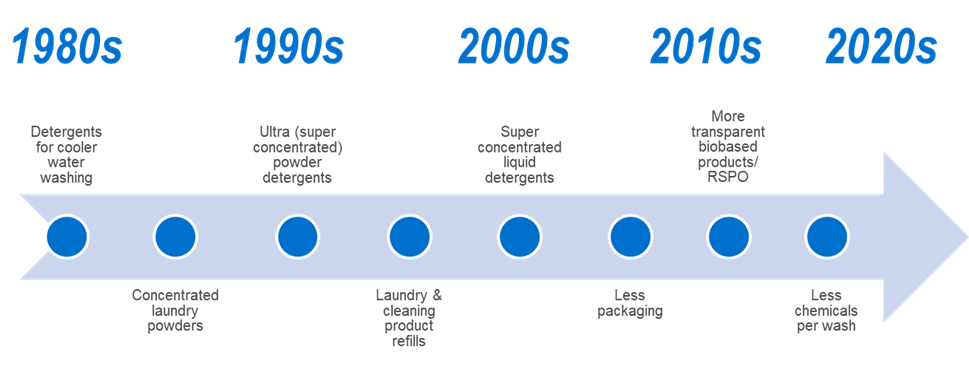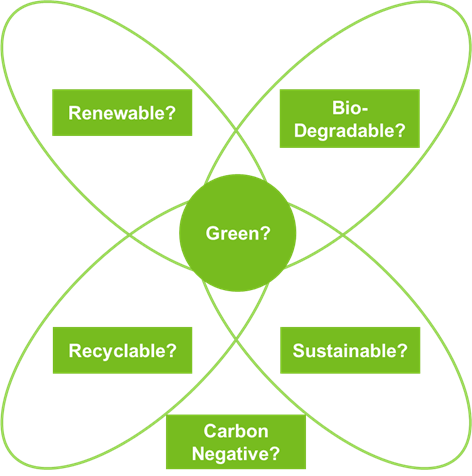Surfactants and Sustainability

Sustainability is front-page news. In the past year, we heard about single-use plastics, the European Green Deal, Greta Thunberg scolding world leaders, promises to “build back better”, wildfires, floods and the COP26. The trend is clear: whether climate change, loss of biodiversity or waste reduction is spotlighted, sustainability[1] is a key concern.
What impact will the trend towards increasing sustainability have on the surfactants industry?
Notably, the surfactants industry is one step ahead compared to many other chemical/process industries when thinking about sustainability. Some decades ago, branched alkyl benzene sulfonates (BABS) were replaced by the more biodegradable linear alkyl benzene sulfonates (LABS) due to environmental concerns and phosphates banned due to adverse effects on ecosystems, such as algal blooms. Concentrated and ultra-concentrated detergents, which have a reduced carbon footprint associated with transportation and packaging, are now standard. Moreover, a drive to reduce water temperatures, and hence energy usage, in washing machines and dishwashers has impacted detergent formulations and contributed to an increasing use of enzymes.
With this background it is not surprising that Unilever has announced plans to phase out all virgin fossil carbon in its cleaning products by 2030 or L’Oréal has announced it will source 95% of its ingredients from renewable sources by the same date. Unilever has also purchased Seventh Generation, which includes plant-based detergents and household cleaners in its product portfolio, and P&G has launched Ariel purclean, which is a 70% plant-based detergent.
Sustainability has been one of the objectives considered in the development of new detergent products for over 50 years
Sustainability considered in the development of new detergent products

There is reason to believe the surfactants industry will be at the forefront of the chemicals industry in improving sustainability: products containing surfactants are used in everyday life and easily recognised by non-experts as “chemicals” and therefore, similarly to plastic packaging, consumer pressure can have a large impact on producers. For example, consumer concerns about the uses of sulfates in shampoo or the toxicity of 1,4-dioxane have already impacted formulators and surfactant producers upstream.
However, for brands to deliver on promises to improve sustainability, the supply landscape must change correspondingly. There has indeed been investment by major producers into renewable surfactants:
Croda produces bio-ethylene oxide (derived from bio-ethanol) in its Delaware plant in North America, which goes into its “ECO range" of ethoxylated surfactants
BASF, Nouryon, and SEPPIC have invested in Alkyl polyglucosides (APGs) capacity, and Clariant in alkyl glucamides (AGs). APGs and AGs are produced from glucose and fatty alcohols.
Ajinomoto in Japan produces amino acid-based surfactants, and recently invested in Amisoft® glutamates capacity at a new plant in Brazil.
Evonik and various smaller surfactant companies have invested in sophorolipids (a glycolipid produced by yeasts). Evonik also announced it would be pursuing the commercialisation of rhamnolipids.
These products have achieved commercial success and there has been strong demand growth. However, total capacity is still less that 5% of the total supply of surfactants and the current reality is that the bulk of surfactants is produced from synthetic or oleochemical feedstocks.
What challenges and opportunities are expected to govern future investment into more sustainable surfactants?
The biggest challenge is cost. Surfactants typically contribute the most to the overall raw material cost of detergents formulations. Hence, formulators are strongly motivated to focus on keeping surfactant costs low, especially as their customers, mainly retailers, are very resistant to price pass-through. However, from NexantECA analysis, the cost to produce renewable surfactants can be at least double the cost of producing surfactants from synthetic or oleochemical feedstocks (refer to NexantECA Surfactants Biorenewable Insights report 2018 and NexantECA Alkoxylation TECH report 2020). This is a considerable barrier to widespread adoption, even though the market for renewable surfactants could have strong growth in more specialty applications. It is therefore not surprising that NexantECA has heard from industry contacts that interest in renewable surfactants reduced in recent years when crude oil prices were relatively lower (i.e. below $50 dollars per barrel).
One potential solution is regulatory or fiscal measures to either incentivize investment in more sustainable surfactants or to penalize less sustainable surfactants. However, caution is advised: the EU green fuels law led to rampant deforestation to make way for palm oil plantations in Southeast Asia since 2010, illustrating how sustainability legislation can backfire catastrophically. Consequently, it will be critical when transitioning to more sustainable surfactants to holistically consider different sustainability objectives. For example, when comparing the overall sustainability of synthetic, oleochemical or bio-based surfactants, there are complex questions to answer, as illustrated by the following case studies:
A recent report[2] showed that while palm oil leads to deforestation and biodiversity losses, replacing it with other types of vegetable oils could be worse for the environment overall, by shifting environmental damage to other regions. This is mainly because the oil yield for palm oil is far higher than alternative vegetable oils. Moreover, the palm kernel oil (PKO) used in detergents is a coproduct of palm oil, which if not used in detergents, could end up wasted. The question is then: is a surfactant produced from a rapeseed crop in Europe, using more agrochemicals and potentially taking available land from food crops, really more sustainable than PKO sourced from Malaysia?
Many synthetic feedstocks used to make detergents are co-products from other processes (e.g. linear alpha olefin (LAO) cuts, butylene, propylene or n-paraffins), and therefore their use in detergents arguably avoids waste. Moreover, one academic study (funded by Air Products and Chemicals Inc) showed that synthetic fatty alcohols had overall lower average greenhouse gas emissions (~2.97 kg CO2e) compared to fatty alcohols derived from PKO (~5.27 kg CO2e)[3] . Therefore, are detergents produced from PKO really more sustainable than those produced from synthetic feedstocks?
Sustainability must be assessed holistically
Sustainability must be assessed holistically

Besides these questions, there is also the question of how to transition to more sustainable alternatives without negatively impacting regional cost competitiveness. For example, any carbon tax implemented in Europe could make the regional industry uncompetitive unless this is carefully considered and accounted for within the local regulatory measures.
Conclusion
Surfactants are a cornerstone of civilization and the need to improve sustainability is clear. Yet the solution is not as simple as we hope it will be. Similarly, compared to many other chemical/process industries, it is not easy to see how the surfactants industry can become significantly more sustainable without larger paradigm shifts, whether from fiscal incentives such as a carbon tax or largescale investment in low-cost renewable energy. Hopefully this will be forthcoming in the near future.
Find out more...
Market Insights: Ethoxylates - 2021 This report provides analysis and forecast to 2035 of the global ethoxylates market, including supply of ethoxylates, commentary on the upstream value chain and demand into household, personal care and others.
Alkoxylation Technologies (2020 Program) This report provides a comprehensive analysis of the alkoxylation technology used to produce surfactants, including the economics, and markets for the production of ethoxylates. Commercial process technologies based on both the conventional stirred tank reactor system and representative loop reactor systems are discussed. Cost of production estimates of these production routes are included to illustrate the cost competitiveness of different ethoxylate products in selected regions. A market review including regional ethoxylation capacities and supply/demand figures is also presented.
Detergent Alcohols (2019 Program) Commercial technologies and trends for producing detergent alcohols are discussed in detail. Process economics for several technologies, including synthetic and fatty alcohols, have been developed (U.S., N.W. Europe, and South-East Asia bases). Regional market supply/demand and commercial applications are included.
The Author
Robert Hogan, Senior Analyst
[1] The definition of “sustainability” used in this blog is as broad as possible, similar to the definition used in the United Nations Brundtland Commission, which defined sustainability as “meeting the needs of the present without compromising the ability of future generations to meet their own needs.”
[2] IUCN report https://portals.iucn.org/library/node/47753
[3] Comparison of Oleo- vs Petro-Sourcing of Fatty Alcohols via Cradle-to-Gate Life Cycle Assessment. CO2e refers to the Carbon dioxide equivalent of global warming potential